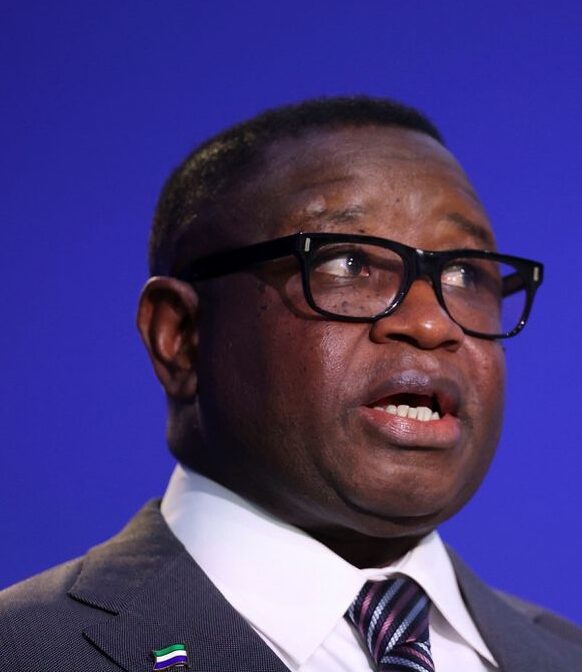The Monetary Policy Committee of the Bank of Sierra Leone met on 6 July 2023. The Acting Governor. Dr. Ibrahim L. Stevens chaired the meeting. The Committee reviewed recent macroeconomic and financial developments in the global and domestic environments and their implications for domestic inflation and growth. Following the deliberations, the MPC decided to increase the Monetary Policy Rate by 0 50 percentage points, to 19.25 percent. A summary of the assessment and key considerations that informed the Committee’s decision on the stance of monetary policy is provided below:
GLOBAL ECONOMIC DEVELOPMENTS
The IMF has revised its global growth projections for 2023 and 2024 downward by 0.1 percentage point, to 2.8 percent and 3.0 percent respectively. The Monetary Policy Committee (MPC) noted that the global economic outlook remains uncertain despite the decline in food and energy prices. the re-opening of the Chinese economy, and general improvement in business and consumer confidence. Moreover, heightened levels of uncertainty persist due to the associated risk of contagion from the financial sector turbulence in the United States and ongoing geopolitical tensions. The MPC also noted that downside risks still remain and continue to slow the rebound in global economic activity, which is further compounded by challenges in global trade, sovereign debt crises and tightening of credit conditions.
Commodity prices are expected to fall during 2023 and pick up in 2024. Both energy and non- energy prices are expected to slow down in 2023 due to weaker-than-expected demand. Also, there has been a decreasing trend in food prices with the ease in global supply chain disruptions and redirection of trade for agricultural inputs. However, commodity prices are expected to remain above pre-pandemic level, which will continue to weigh on affordability and food security.
Given these developments, the MPC is of the view that the decrease in global food and energy prices, coupled with the improvement in global supply chains, is expected to reduce the country’s import bill. Additionally, strong iron ore prices may boost export receipts. Moreover, the receding global commodity prices may also translate into lower imported inflation going forward.
INFLATION OUTLOOK
Since the last MPC meeting, inflationary pressures have persisted, with headline inflation increasing by a higher margin amidst demand and supply pressures. Headline inflation increased from 41.74 percent in March 2023 to 44.43 percent in May 2023, which is largely driven by both food inflation and non-food inflation. The increase in the inflation rate reflects depreciation of the currency, the lingering effects of the Ukraine-Russia war, tight global liquidity conditions and domestic supply side constraints. Despite the highlighted problems, inflation is expected to recede towards the end of 2023, consistent with the contractionary stance adopted by both the fiscal and monetary authorities
DOMESTIC ECONOMIC ACTIVITY
Real GDP growth moderated to 3.6 percent following a strong rebound of 4.1 percent growth in 2021. due to multiple supply side shocks. Growth is projected to slowdown to 2.7 percent in 2023 from an initial estimate of 3.4 percent, due to less-than expected improvement in mining output and uncertainties surrounding the other growth sectors, as well as the impact of the Russia-Ukraine war. This evidence is corroborated by the Bank’s analytical high frequency indicator of economic activities, the Composite Index of Economic Activity (CIEA), which signaled a slight improvement in economic activity during 2023Q1 but forecasted to slow by 2023Q3. Going forward, domestic economic activity is projected to reach 4.2 percent, on average, over the medium-term (2023-2025), driven mainly by the anticipated increase in agricultural investment. possible increase in other mining activities, expansion in manufacturing, recovery in the tourism. sector and the general improvement in the business environment, as the implementation of the much-needed financial sector and regulatory reform continue.
EXTERNAL SECTOR DEVELOPMENTS
The trade deficit narrowed to US$159.53mn in 2023Q1 from US$200.17mn in 202204, driven by improved export earnings and a reduction in the import bill. This was reinforced by improvement in the terms-of-trade and some improvements in global supply chain conditions, supported by the reopening of China. The gross foreign exchange reserves of the Bank of Sierra Leone (BSL) remain sufficiently stable to cover at least 3.3 months of imports of goods and services. Although the Leone had depreciated against major international currencies in the review period, the exchange rate had been relatively stable during 2023Q2. There was a significant appreciation of the Leone in June 2023, due mainly to the increase in supply of foreign currency in the market because of election-related inflows, other seasonal inflows, and the decrease in demand for foreign currency for the importation of essential items, suggesting that some importers had acquired adequate stock levels by May 2023 to cover 2023Q2 and 2023Q3.
The MPC acknowledged that the continued coordination between fiscal and monetary policy to support productive sectors, increasing iron ore exports and the declining trend in global food and
energy prices, will reduce pressures in the foreign exchange market.
FISCAL DEVELOPMENTS
The overall fiscal deficit widened to NLe1.81bn in 2023Q1 from NL.c0.85bn in 202204, as total government revenues declined more than the reduction in government expenditures. With the decline in domestic revenue, the MPC was of the view that implementation of policy measures to reduce discretionary spending and raise tax revenues, while freeing up resources for priority expenditure, should be accelerated.
MONEY AND BANKING
Movements in monetary aggregates were expansionary in 202301, reflecting the increase in the growth rate of both Reserve Money and Broad Money. The growth in Reserve Money was driven by Net Domestic Assets (NDA) of the BSL, while growth in Broad Money was influenced by NDA of the banking system. Private sector credit also grew but remained concentrated to a few sectors -commerce and finance, business and personal services, and construction. The MPC noted with concern the concentration of credit to a few sectors in the market and urged commercial banks to increase credit to other sectors, including the agriculture sector, to support growth and development.
The government treasury securities market remained undersubscribed during 2023Q1, mainly reflecting the tight liquidity conditions in the banking system. The BSL had to conduct secondary market operations with commercial banks to support market liquidity. The yield on the 364-day Treasury Bill averaged about 28 percent in 2023Q1. With the tight liquidity conditions in banking system, there is an urgent need for commercial banks to embark on deposit enhancing activities. including narrowing the margin between lending and deposit rates.
FINANCIAL SYSTEM STABILITY
Most of the Financial Soundness Indicators (FSIs) monitored by the BSL remained above their prudential threshold, indicating overall banking sector resilience. However, the MPC noted systematic risks to the banking and financial sector, which includes the high NPL ratio, the limited intermediation with credit skewed to a few sectors, and the overreliance on investment in government securities. To support private sector growth and development, commercial banks should, both individually and collectively, modernise their business model, to increase financial intermediation.
CONCLUSION
The MPC acknowledges that current inflationary pressures pose a challenge for domestic macroeconomic stability and the potential impact on real household incomes. Upside risks, such as exchange rate pressures, monetary expansion, increased government expenditure, and inflationary expectations, reinforces these concerns. Despite these upside risks, there are downside risks to the outlook, including lower imported inflation due to receding global commodity prices and strong iron ore prices, potentially mitigating the depreciation of the exchange rate and its attendant inflationary effects. Therefore, based on its assessments of the risks to inflation and economic activity in the near-term, and considering the BSL’s responsibility to safeguard price and financial system stability, while supporting economic growth, the MPC decided to raise the Monetary Policy Rate (MPR) by 0.50 percentage points, to 19.25 percent, and adjust the Standing Lending Facility Rate by the same margin, while the Standing Deposit Facility Rate remain unchanged.
Hence, effective 10 July 2023, the following rates are published for the information of the public:
Monetary Policy Rate (MPR): 19.25 percent
Standing Lending Facility Rate (SLFR): 22.25 percent Standing Deposit Facility Rate (SDFR): 12.75 percent
The MPC also underscores the importance of policy reforms in productive sectors of the economy. particularly agriculture, to support aggregate supply for growth and development. Additionally, better coordination between fiscal and monetary policy, together with the expected financing from development partners, will alleviate depreciation pressures and reduce inflation in the medium-term. The MPC will continue to monitor domestic economic developments and stands ready to act accordingly, signalling its intention to bring down inflation.
Ibrahim L. Stevens (Dr.) Acting Governor














